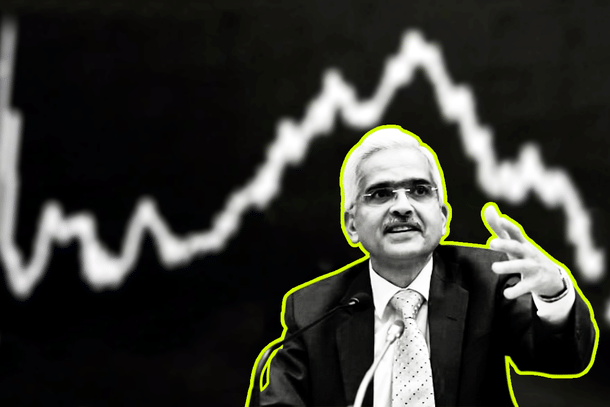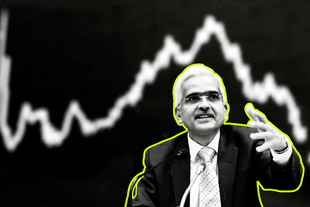News Brief
Geo-Political Crisis, Oil Prices Risks Prompt RBI To Pare Down FY23 Growth
Swarajya Staff
Apr 08, 2022, 07:12 PM | Updated 07:12 PM IST
Save & read from anywhere!
Bookmark stories for easy access on any device or the Swarajya app.


Amid concerns over escalation in geo-political stress undermining global recovery and some inevitable concern over impact on India, the Reserve Bank of India on Friday (8 April) pared down India’s GDP growth estimate for 2022-23 to 7.2 per cent -- a significant downward revision from its earlier projection of 7.8 per cent.
The GDP growth for Q1 FY2022-23 is projected at 16.2 per cent, 6.2 per cent for Q2, 4.1 per cent for Q3, and 4.0 per cent for Q4, assuming Indian basket of crude oil at $100 per barrel during 2022-23. The Asian Development Bank (ADB) has projected India growing by 7.5 per cent in the current fiscal year before picking up to 8 per cent the next year.
A combination of factors is seen to have prompted a more hawkish stance on the part of the RBI in the first Monetary Policy Review for the financial year 2023.
Despite a strong economic recovery and a less disruptive Omicron wave, the expected positive effects of the omicron waning off have been jeopardised by the global geo-political tensions, rising risk aversion towards emerging markets has led to outflow of funds and weakened the currency and global supply chain disruption owing to geo-political tensions and resurgence in covid in some countries run the risk of input cost pressures.
In the light of the risks from excessive volatility in global crude oil prices and extreme uncertainty due to geo-political tensions, forecasts of growth and inflation would be contingent on future oil and commodity price developments.
The RBI has thus maintained an accommodative stance in maintaining the repo rate at 4 per cent towards ensuring liquidity in the country and further pumping up investor sentiments which will help beat a possible slowdown in economic activity due to geo-political tensions while promising to keep a tab on inflation.
Concern over inflationary pressures has remained on fore, as reflected in the upward revision in the forecast for consumer price index (CPI) inflation for FY 2022-23 from 4.5 per cent to 5.7 per cent. The in the first quarter of FY23 shall rise 6.3 per cent, followed by 5 per cent in the second quarter. In the September to December and January to March quarters, the economy is expected to witness jump by 5.4 per cent and 5.1 per cent, respectively.
Last fiscal, CPI inflation was mainly controlled on account of low food inflation, supported by favourable base effect, and limited passthrough of cost pressures to core inflation amid weak demand. As part of its strategy going forward, the RBI has signalled a withdrawal of accommodation and moving towards normalisation of liquidity management to ensure inflation remains within target as upside risks show no signs of abating with crude oil prices persisting above $100 per barrel and food inflation looking at escalation due to surging international food prices and input costs for agriculture.
Dharmakirti Joshi, Chief Economist of CRISIL, expects core inflation to rise above 6 per cent as producers increase passthrough of input costs amid improving demand conditions. The RBI has hinted at shifting focus from reviving growth to mitigating inflation risks and a calibrated removal of accommodation in this fiscal, points out Joshi.
In a concrete step on Friday, the central bank restored the policy rate corridor under liquidity adjustment facility (LAF) to pre-pandemic width of 50 basis points by introducing standing deposit facility (SDF) at 3.75 as the floor of this corridor. According to Joshi, this narrowing of LAF corridor will prepare the markets for repo rate hikes which is expected to be 50-75 basis points in fiscal 2023, beginning with the June monetary policy review.
“Inflation in India is supply side driven and support from government in terms of fiscal measures such as reduction in excise duty and VAT on petrol/diesel by the Centre and states can help mitigate immediate concern on inflation to some extent,” suggests Sanjiv Mehta, FICCI President.
For the common man bearing the inflationary pressure, the continuation of the current repo rate regime would ensure that home loan rates remain low, leading to continued buyer interest in the residential sector, says Anshuman Magazine, Chairman & CEO - India, South-East Asia, Middle East & Africa, CBRE.
However, it is inspiring to note that India has strong buffers, including large foreign exchange reserves, significant improvement in external sector indicators and strengthened financial sector, to sustain the country’s economic recovery and growth. According to the second advance estimates released by the National Statistics Office (NSO) on 28 February 2022, the real GDP rose by 8.9 per cent in 2021-22.
Private consumption and fixed investment key drivers of the domestic demand, however remain subdued with these two components being only 1.2 per cent and 2 per cent respectively above their pre-pandemic levels. On the supply side, contact intensive services still trail the 2019-20 level. “Nevertheless the Indian economy is steadily reviving from its pandemic induced contraction,” RBI Governor Shaktikanta Das said in a briefing.
Engineering exports promotion body Chairman Mahesh Desai sees the decision to keep the policy repo rate unchanged as a big positive for the industry witnessing recovery after two years of stress caused by Covid pandemic. The RBI's move would ensure further credit support and spur the growth momentum. Despite mounting inflationary pressure, the RBI has shown its commitment to push growth.
Also Read: How Modinomics Proved The 'Experts' Wrong: Extreme Poverty Fell Even During Pandemic





